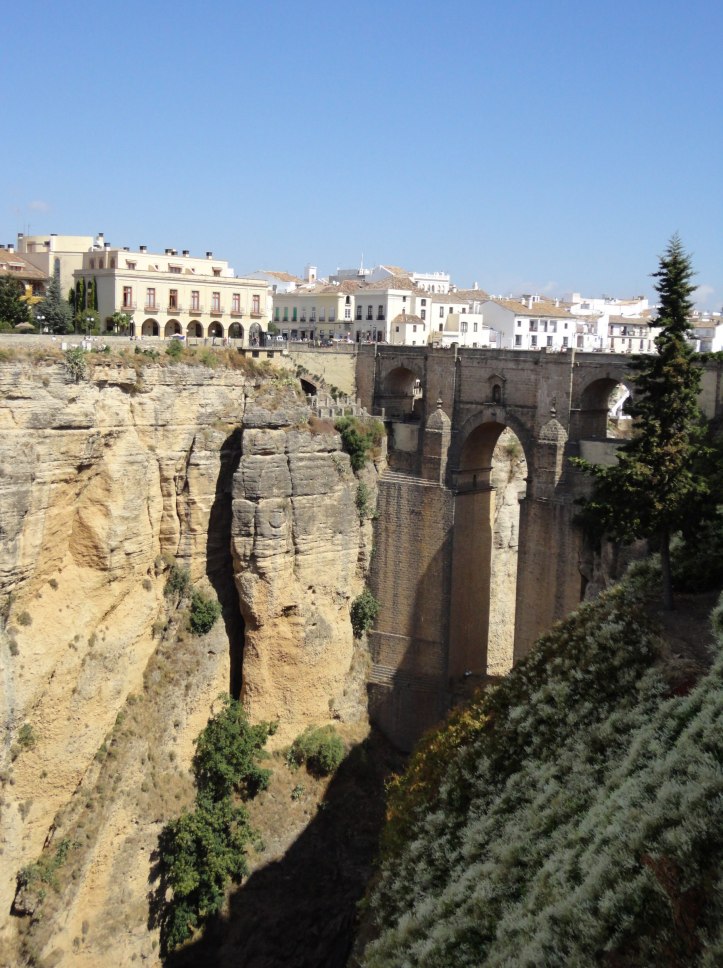
Stage 2 took the peloton from the marble-white beaches of Marbella up into the mountains and the stunning architecture of the Caminito del Rey, a series of narrow walking paths and floating bridges carved into the stone. They were built to facilitate the construction of the Conde de Guadalhorce Dam: it was the easiest and safest (hmmm . . .) way for workers to cross from one side of the gorge to the other, making it easier to transport materials. That effort began in 1901 and, in 1921, King Alfonso XIII traversed the bridge himself, earning the crossway the name Caminito del Rey, or Path of the King.
Nowadays, the paths are open to hikers (brave ones) who meander up the mountain single-file, hoping for a glimpse of the vast valley below. Me? I’ll settle for a photo!

On Monday, Stage 3 begins in Mijas, one of Andalucía’s famous white towns, named for the white-washed surface of the buildings that dot the hillsides, glistening like pearls in the bright sun. The race route heads west along the coast, through Marbella, then turns sharply north into the mountains again – toward one of my favorite places in Spain.
Ronda and the Tajo Gorge
While not far from the sea, Ronda is not easily accessed. Driving up the narrow, winding roads is not for the faint of heart, but the payoff is well-worth the effort. Smugglers thought so, too, back in the day. They would bring their illicit goods to the coast under cover of night, when they would drag their treasure ashore. Accomplices with horses would distribute the load, weighing each horse down with as much as it could bear. Then they would escape into the hills, ascending invisible paths to safety, atop the gorge in Ronda.

Wines of the Serranía de Ronda DO – Bodegas F. Schatz
With roots in the Südtirol (in northeastern Italy) and Baden in southern Germany, the Schatz family has made wine since 1641. In the 1980s, Friedrich Schatz relocated to Spain, in search of the perfect place to make wines meant to express a unique terroir, using a wide variety of grapes. He settled on the area now known as Serranía de Ronda, where vines would have the advantage of elevation and proximity to the mountains – important in moderating the hot, dry climate in southern Spain.
Today, Schatz has been joined by other winemakers who foresaw the potential to make dry table wines of high quality here. The sub-region now boasts 23 bodegas (wineries) and about 250 hectares of vineyards.

Farming methods at Schatz are organic and biodynamic and include the planting of cover crops to help replenish nitrogen levels in the soil. Peas, garbanzo beans, and clover flourish between the vines, providing protection against erosion as well. It looks like they raise chickens, too.
Yields are aggressively managed, and careful attention is paid to disease and pest prevention. A high, loose canopy that allows air circulation promotes ripening; it also ensures that precipitation (higher here than elsewhere in the region) dries out before problems can start.

Currently, F. Schatz offers six different wines – some familiar to lovers of Spanish libations, others less so. For starters, there’s varietal Chardonnay, Pinot Noir, and Petit Verdot; and Finca Sanguijuela, a red blend of Tempranillo, Syrah, Merlot, and Cabernet Sauvignon. Then add in a Rosado made from Moscatel Negra – a clear nod to the traditional winemaking history in this region. Now for the cherry on top: Acinipo, a varietal Lemburger wine named after the winery’s home city of Ronda, originally called Acinipo (City of Wine) by the Romans.
You can read more about the innovative winemaking process at F. Schatz Premium Wines here.
I hope you enjoy the beauty of southern Spain as the peloton pedals through Stage 3. Stay tuned for details on Stage 4, which heads east along the Mediterranean coast, then swings inland for a few challenging climbs.
Viva la Vuelta!
[…] Swirling Dervish visits Andalucia in the south of […]
LikeLike
I’m with you… I’ll settle for a photo of Caminito del Rey too! Cheers!
LikeLiked by 1 person
My sister-in-law visited the area last summer, and she and her son hiked the Caminito. Braver than I am, for sure!
LikeLike
Have heard great things about Rhonda, didn’t realize it was at a higher altitude. Kudos to Schultz for his agricultural practices!
LikeLiked by 1 person
On the map it looks close to Marbella, and it is. But the route up the mountain is a wild ride! Good for cyclists though. 🙂
LikeLike
I love this region of Spain. Your photos take me back
LikeLiked by 1 person
Thanks. Writing about it takes me back, too.
LikeLike